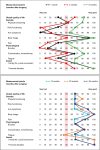Long-term improvement of quality of life in patients with breast cancer: supporting patient-physician communication by an electronic tool for inpatient and outpatient care
- PMID: 34176020
- PMCID: PMC8550515
- DOI: 10.1007/s00520-021-06270-1
Long-term improvement of quality of life in patients with breast cancer: supporting patient-physician communication by an electronic tool for inpatient and outpatient care
Abstract
Purpose: The effectiveness of a pathway with quality of life (QoL) diagnosis and therapy has been already demonstrated in an earlier randomized trial (RCT) in patients with breast cancer. We refined the pathway by developing and evaluating an electronic tool for QoL assessment in routine inpatient and outpatient care.
Methods: In a single-arm study, patients with breast cancer with surgical treatment in two German hospitals were enrolled. QoL (EORTC QLQ-C30, QLQ-BR23) was measured with an electronic tool after surgery and during aftercare in outpatient medical practices (3, 6, 9, 12, 18, and 24 months) so that results (QoL-profile) were available immediately. Feedback by patients and physicians was analyzed to evaluate feasibility and impact on patient-physician communication.
Results: Between May 2016 and July 2018, 56 patients were enrolled. Physicians evaluated the QoL pathway as feasible. Patients whose physician regularly discussed QoL-profiles with them reported significantly more often that their specific needs were cared for (p < .001) and that their physician had found the right treatment strategy for these needs (p < .001) compared with patients whose doctor never/rarely discussed QoL-profiles. The latter significantly more often had no benefit from QoL assessments (p < .001).
Conclusion: The QoL pathway with electronic QoL assessments is feasible for inpatient and outpatient care. QoL results should be discussed directly with the patient.
Clinical trial information: NCT04334096, date of registration 06.04.2020.
Keywords: Breast cancer; Complex intervention; Electronic assessment; Patient-physician communication; Patient-reported outcomes; Quality of life.
© 2021. The Author(s).
Conflict of interest statement
The authors declare that they have no conflict of interest.
Figures



Similar articles
-
Cloud-Based Service Information System for Evaluating Quality of Life after Breast Cancer Surgery.PLoS One. 2015 Sep 30;10(9):e0139252. doi: 10.1371/journal.pone.0139252. eCollection 2015. PLoS One. 2015. PMID: 26422018 Free PMC article. Clinical Trial.
-
Diagnosing deficits in quality of life and providing tailored therapeutic options: Results of a randomised trial in 220 patients with colorectal cancer.Eur J Cancer. 2020 May;130:102-113. doi: 10.1016/j.ejca.2020.01.025. Epub 2020 Mar 13. Eur J Cancer. 2020. PMID: 32179445 Clinical Trial.
-
Determinants and patient-reported long-term outcomes of physician empathy in oncology: a structural equation modelling approach.Patient Educ Couns. 2007 Dec;69(1-3):63-75. doi: 10.1016/j.pec.2007.07.003. Epub 2007 Sep 11. Patient Educ Couns. 2007. PMID: 17851016
-
The effect of scalp cooling on CIA-related quality of life in breast cancer patients: a systematic review.Breast Cancer Res Treat. 2019 Jun;175(2):267-276. doi: 10.1007/s10549-019-05169-0. Epub 2019 Feb 26. Breast Cancer Res Treat. 2019. PMID: 30806923
-
Quality-of-life considerations in the treatment of early-stage breast cancer in the elderly.Drugs Aging. 2010 Oct 1;27(10):791-800. doi: 10.2165/11584700-000000000-00000. Drugs Aging. 2010. PMID: 20883059 Review.
Cited by
-
Reframing Patient Experience Approaches and Methods to Achieve Patient-Centeredness in Healthcare: Scoping Review.Int J Environ Res Public Health. 2022 Jul 27;19(15):9163. doi: 10.3390/ijerph19159163. Int J Environ Res Public Health. 2022. PMID: 35954517 Free PMC article.
-
Effectiveness of an online support program to help female cancer patients manage their health and illness: Protocol for a randomized controlled trial.Contemp Clin Trials Commun. 2022 Nov 10;30:101035. doi: 10.1016/j.conctc.2022.101035. eCollection 2022 Dec. Contemp Clin Trials Commun. 2022. PMID: 36387994 Free PMC article.
References
-
- Wöckel A, Schwentner L, Krockenberger M, Kreienberg R, Janni W, Wischnewsky M, Thorsten K, Felix F, Riccardo F, Blettner M, Singer S. Predictors of the course of quality of life during therapy in women with primary breast cancer. Qual Life Res. 2017;26(8):2201–2208. doi: 10.1007/s11136-017-1570-0. - DOI - PubMed
-
- Couwenberg AM, Burbach JPM, van Grevenstein WMU, Smits AB, Consten ECJ, Schiphorst AHW, Wijffels NAT, Heikens JT, Intven MPW, Verkooijen HM. Effect of neoadjuvant therapy and rectal surgery on health-related quality of life in patients with rectal cancer during the first 2 years after diagnosis. Clin Colorectal Cancer. 2018;17(3):e499–e512. doi: 10.1016/j.clcc.2018.03.009. - DOI - PubMed
-
- Braeken APBM, Kempen GIJM, Eekers D, van Gils FCJM, Houben RMA, Lechner L. The usefulness and feasibility of a screening instrument to identify psychosocial problems in patients receiving curative radiotherapy: a process evaluation. BMC Cancer. 2011;11:479. doi: 10.1186/1471-2407-11-479. - DOI - PMC - PubMed
-
- Cleeland CS, Wang XS, Shi Q, Mendoza TR, Wright SL, Berry MD, Malveaux D, Shah PK, Gning I, Hofstetter WL, Putnam JB, Jr, Vaporciyan AA. Automated symptom alerts reduce postoperative symptom severity after cancer surgery: a randomized controlled clinical trial. J Clin Oncol. 2011;29:994–1000. doi: 10.1200/JCO.2010.29.8315. - DOI - PMC - PubMed
MeSH terms
Associated data
Grants and funding
LinkOut - more resources
Full Text Sources
Medical

